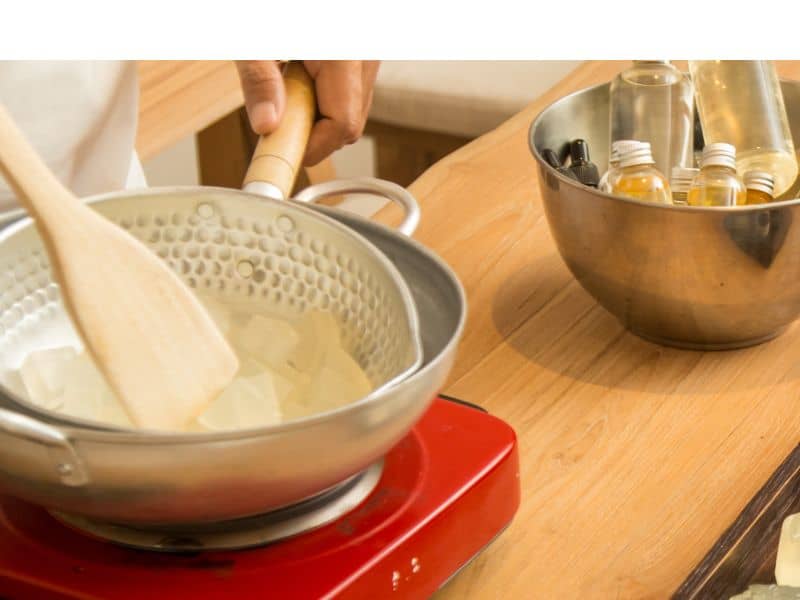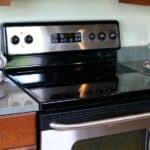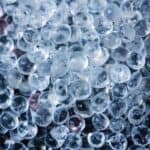Crafting homemade soap is a blend of science and art, allowing you to create something beautiful, useful, and uniquely yours. You can experiment with different ingredients, textures, and colors, leading to an endless variety of soap. Plus, there’s a deep sense of satisfaction in using a soap bar that you’ve made from scratch.
You can produce a batch of soap bars in a couple of hours, unlike other methods which can take weeks. In addition, the creative possibilities are endless. You can experiment with different colors, scents, and additives, and even layer colors for a striking effect. However, sometimes you experience some melt and pour problems.
The good news is that some of these melt and pour problems are easier to fix than you think. Let’s take a look at some of these common soap making problems and what you can do to fix them.
Melt and Pour Soap Problems (And How To Fix Them)
Soap Melting Problems
Melting soap seems straightforward, but it’s easy to make mistakes. One common error is overheating the soap, which can cause it to burn, discolor, or lose its lathering ability. On the other hand, if the soap isn’t heated enough, it won’t fully melt, leading to a lumpy mixture.
Finding the right temperature to melt your soap is crucial. The sweet spot is generally between 120-125°F (49-52°C). At this temperature, the soap base melts smoothly without burning. A cooking thermometer is a handy tool to ensure you’re in the right range.
The best technique for melting soap is using a double boiler. This method gently and evenly heats the soap, reducing the risk of burning. It involves placing the soap in a heat-proof bowl, then setting that bowl over a pot of simmering water. The steam from the water heats the bowl, melting the soap inside. Always stir the soap gently as it melts to ensure even heating.
Issues with Soap Texture
Soap texture is a key aspect of its quality. It should feel pleasant in the hand and on the skin. Sometimes, soap turns out too hard, making it uncomfortable to use. On the other hand, soap that’s too soft can become mushy and dissolve quickly. Both scenarios are less than ideal.
The ingredients you use in your soap significantly impact its texture. For example, too much oil can lead to a softer bar, while certain additives can make it hard. The type of soap base you use also plays a part. Some bases are designed to produce harder bars, while others result in softer soap.
To get the perfect texture, it’s crucial to measure your ingredients accurately and follow the recipe. If you’re looking for a harder bar, consider adding additives like clay or beeswax. If your soap is too hard, try adding a bit more oil or glycerin. Experimentation is key, but remember, small changes go a long way.
Color Not Turning Out Right (First Instance)
Soap color can sometimes be tricky. It might not turn out as vibrant as you hoped or change during the soap-making process. Other times, the color might fade over time or bleed into other colors in multi-colored bars.
Your soap base can impact your colors. Clear bases will display colors more vibrantly, while white bases can make colors appear pastel. Also, some bases may react with certain colorants, leading to unexpected results.
Firstly, choose your colorants carefully. Micas, liquid soap dyes, and natural colorants like spices and clays can all be used, but each behaves differently. Secondly, make sure to blend your colorants well to avoid clumps. Lastly, storing your soap properly can help maintain color vibrancy.
Soap’s Scent Not Lasting
A common disappointment in soap making is when the beautiful scent fades away too quickly. This can be due to various factors, including not using enough fragrance, the fragrance not being suitable for soap making, or the soap’s pH affecting the scent.
Fragrance oils and essential oils are the two main ways to scent your soap. Fragrance oils are usually stronger and longer-lasting. Essential oils are natural and offer therapeutic properties, but they can be more volatile and fade faster.
To make your scent last, you may need to use more fragrance, but always stay within safe usage rates. Using a fixative like clay or salt can also help. Additionally, curing and storing your soap properly can extend the life of the scent.
Soap Not Lathering Enough
Lather isn’t just for show. It helps distribute soap across your skin, improving its cleansing ability. Plus, who doesn’t love a good, bubbly lather? If your soap isn’t lathering up as you’d like, there are ways to fix it.
Several things can impact soap lather. The type of water you use, the kind of soap base, and the additives you include can all play a part. Hard water, for instance, can reduce lather.
To increase lather, try a different soap base. Some are designed to produce more bubbles. You can also add ingredients that boost lather, like sugar, honey, or certain types of clay. Be careful, though. Too much of these can make your soap soft.
Soap Sweating or Forming Dew
Soap sweat, or glycerin dew, is when small droplets form on your soap’s surface. It’s not harmful, but it can make your soap bars look less appealing. It happens because glycerin, a natural part of soap, attracts moisture.
Many factors can make your soap sweat more. Humidity is a big one. Soap stored in damp conditions is likely to sweat. The type of soap base can also play a role. Glycerin-rich bases, while moisturizing, may sweat more.
To prevent sweat, keep your soap in a cool, dry place. Using a dehumidifier can also help in humid climates. Wrapping your soap in wax paper or shrink wrap is another effective method.
Color Not Turning Out Right (Second Instance)
Fading colors can be a disappointment in soap making. This usually happens over time and can be due to light exposure, certain colorants, or interactions between the soap base and colorant.
Colorants bring your soap to life. However, not all colorants hold up well over time. Some may fade, change color, or bleed into other layers.
Use colorants designed for soap making. They’re more likely to stay vibrant. Also, protect your soap from light as much as possible. Finally, experiment with different colorants and keep notes. You’ll soon learn what works best for you.
Frequently Asked Questions
To prevent soap from sweating, store it in a cool, dry place, use a dehumidifier in humid climates, or consider wrapping the soap in wax paper or shrink wrap.
To boost lather, try a different soap base or add ingredients that increase lather, like sugar, honey, or certain types of clay.
To make the scent last longer, consider using more fragrance (within safe usage rates), use a fixative like clay or salt, or cure and store the soap properly.
Adjust the amount of your ingredients. More oil or glycerin can soften a hard bar, while additives like clay or beeswax can harden a soft one.
Choose your colorants carefully, blend them well to avoid clumps, and store your soap properly to maintain color vibrancy.
Melt and pour soap making is safe, quick, and offers endless creative possibilities. It’s a great method for beginners and those who want to make soap without handling lye.
Conclusion
In conclusion, common soap-making problems are often easier to fix than you might expect. From melting soap correctly to dealing with color and scent issues, you’re now equipped to tackle these common melt and pour soap problems.
Keep learning and experimenting. Every batch of soap is a chance to improve. Remember, even the best soap makers faced challenges when they started. Don’t get discouraged if things don’t go perfectly. Soap making is a journey, and each step brings you closer to creating your perfect bar.






